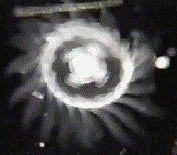| Jellyfish are sea creatures without bones belonging to two classes of the coelenterate phylum: hydrozoa and scyphozoa. A well know jellyfish, strongly portrayed as a classic type in books and films, is the Portuguese-man-of-war which is not a single creature at all. It is a colony of different living forms, polyps, co-operating and working together; some of these do the stinging and killing, while others do the feeding. | |

(c) Wim van Egmond 1998 |
Common jellyfish are slightly different to the man-of-war but are closely related to it. Most people do not realise that the term 'jellyfish' applies really to the free-swimming stage of the common jellyfish: the medusa. They possess no head, anus, bones, gut, eyes, or ears... yet they still have a nervous system, and are able to detect light. |
| In their alternate stage, 'jellyfish' exist as bottom-dwelling polyp called Obelia. These polyps live on the sea bed producing other polyps by asexual reproduction which ultimately will release the free-swimming Medusa. | |
 
(c) Maurice Smith 1998 |
Medusa are bell-shaped and swim by contracting their rim but are normally quite contented to just ride on the ocean current in their quest for food. Their transparent bodies contain little solid matter and are composed of 99% water! |
| Under a microscope, a young jellyfish, obelia, can still be seen to be contracting its rim in that classic jellyfish movement. Next time you are at the seaside or by a river outlet, watch carefully and you will likely see a medusa - full grown exhibiting this lovely rhymic style of movement. | 
(c) Fred Hess 1998 |
| An astonishing feature of the common jellyfish life-cycle
is the way they develop from eggs. The egg is covered with fine hairs which
lash the water, propelling it along until it eventually settles on a stone
or clump of weed and attaches to it. The hairs are lost, the egg grows
longer and a mouth develops at the apex of this half-an-inch long body.
Tentacles grow around the mouth and it lives in this stage, a polyp, for
a considerable time until it is split by a number of constrictions to form
a shape resembling a pile of saucers. Each saucer becomes lobed at its
margin. These develop into 8 'arms' and the 'saucer' eventually breaks
free with the spaces between the arms gradually filling up until a tiny
jellyfish is formed.
Large jellyfish can grow up to over 6 feet wide with most of them packing a very painful sting. In the main, their sting is not fatal to healthy humans except for a few tropical species. Not so for any unsuspecting fish encountering them in the ocean: a physalia, the size of a walnut can kill a fish stronger than a herring - typically, a flying fish or a cuttle-fish. |
|